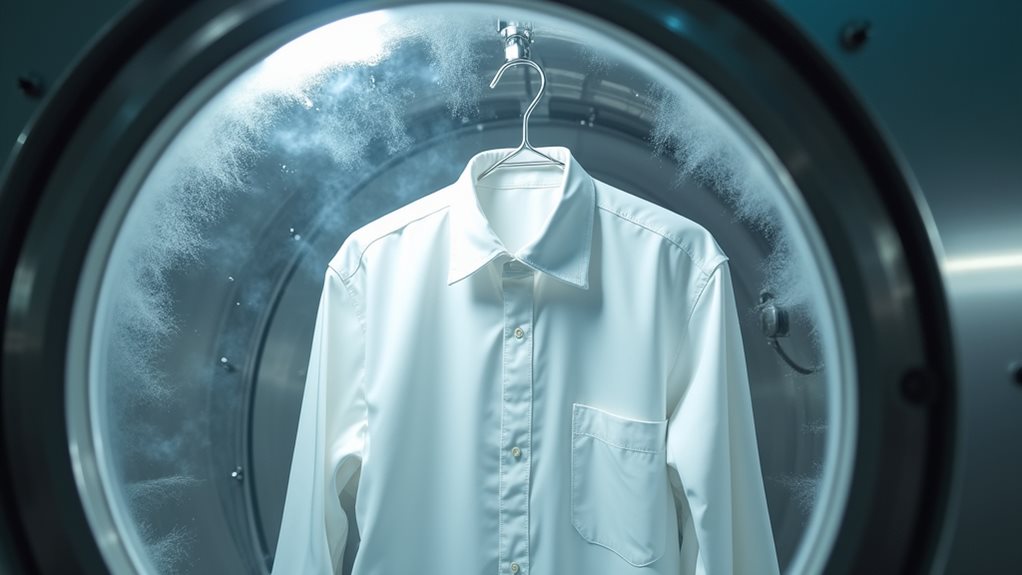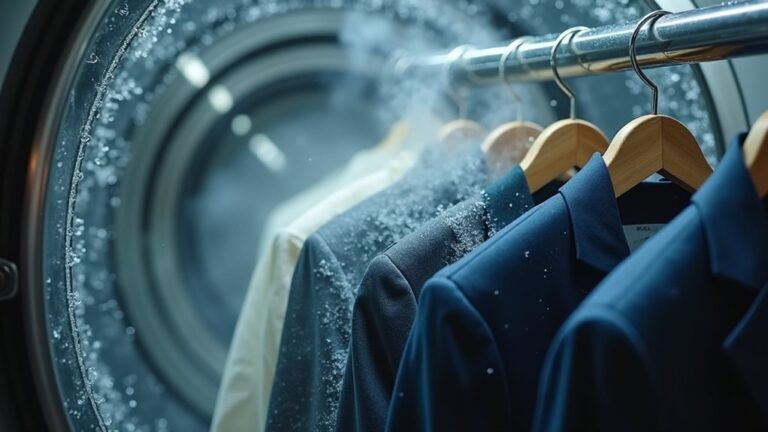When you drop off your favorite silk blouse at the dry cleaner, it’s not actually getting “dried” – it’s getting bathed in liquid chemical solvents like perchloroethylene that dissolve oil-based stains without using water. Your garment gets tagged, pre-treated for stubborn spots, then gently agitated in the solvent before being pressed to perfection. This process preserves delicate fabrics that water would damage, though it struggles with coffee spills and similar water-based mishaps – something you’ll discover has fascinating implications for your wardrobe choices.
The Science Behind Solvent-Based Cleaning
While most of us toss our dirty shirts into the washing machine without a second thought, there’s something almost magical about how dry cleaning works that I didn’t appreciate until I ruined my favorite silk blouse with a home wash disaster 😅.
The dry cleaning process relies on clever chemistry, using cleaning solvents like perchloroethylene instead of water to tackle stubborn oil-based stains on delicate items.
During the wash cycle, modern machines gently agitate your garments in these specialized solvents used at cool temperatures, preserving fabric integrity while lifting dirt effectively.
The real genius happens when the extractor recovers nearly all the solvent for reuse, and newer environmentally friendly solvents are making this process even smarter for our planet’s future.
This method is particularly essential for structured garments like suits and formal wear, as it prevents shrinkage and color bleeding that would occur with traditional water-based washing.
Step-by-Step Dry Cleaning Process
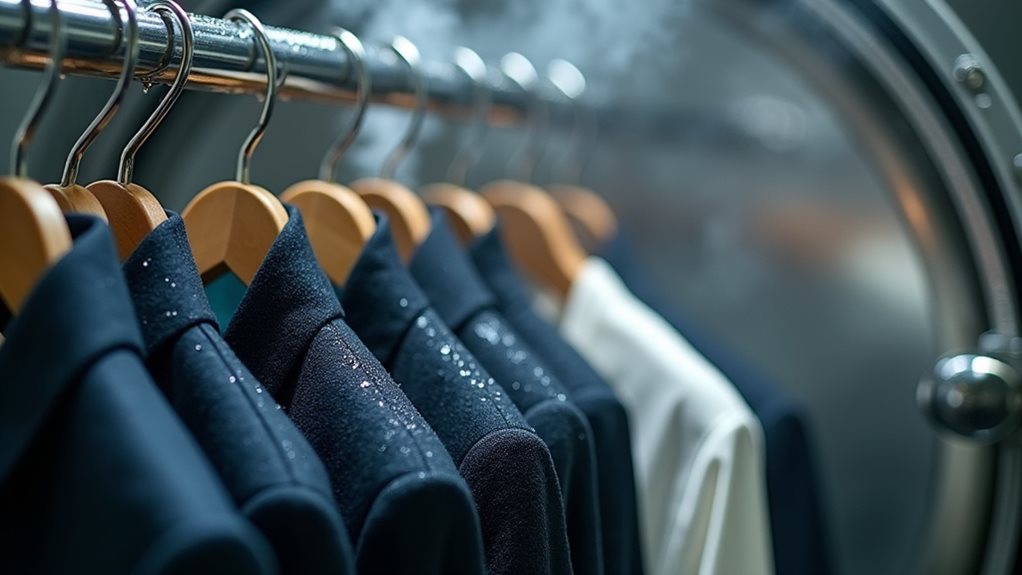
Five distinct steps transform your wrinkled, stained garments into pristine pieces ready for your closet, and honestly, watching this process unfold at my local dry cleaner made me realize why I’d been such a disaster with my own delicate clothes all these years 😊.
First, your clothes get tagged and thoroughly examined, with workers inspecting every inch for damages or forgotten pocket treasures.
Every garment receives meticulous inspection, with experienced staff checking for existing damage and those inevitable forgotten items lurking in pockets.
Next, stubborn stains are pre-treated with specialized cleaning solution formulas.
Then comes the magic: dry cleaning machines use gentle agitation with perchloroethylene solvent to lift dirt without fabric damage. The solvent recovery process recycles nearly 100% of the cleaning chemicals.
Finally, the pressing process eliminates wrinkles, returning your garments looking absolutely perfect.
This method proves particularly beneficial for delicate fibers like silk and wool that would shrink or lose their shape in traditional water-based washing.
Types of Solvents Used in Modern Facilities
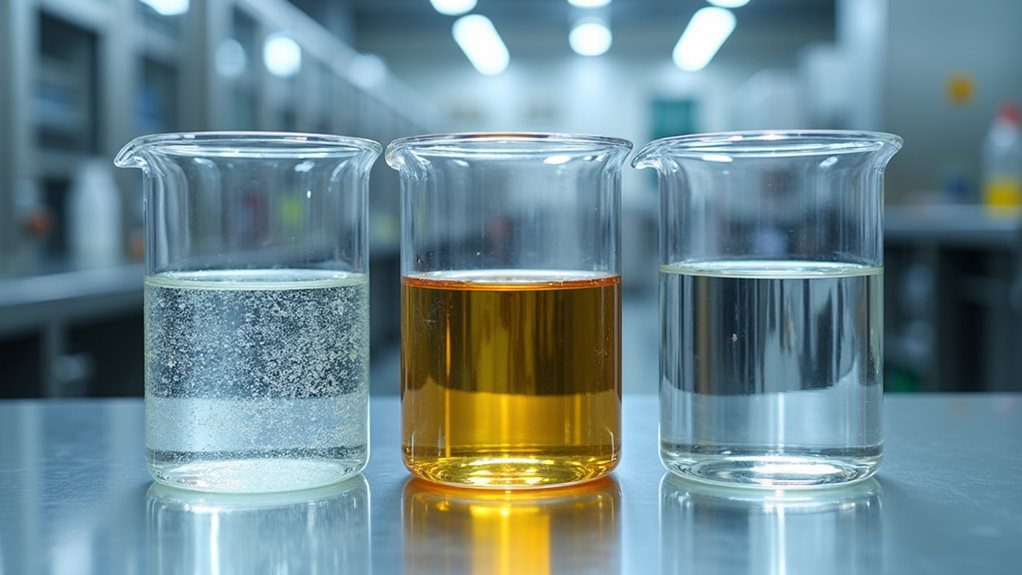
The heart of that impressive cleaning process lies in the chemical solvents that make the magic happen, and after spending way too much time researching this topic (my curiosity gets the better of me sometimes 😅), I discovered there’s actually a fascinating evolution happening in dry cleaning facilities across the country.
While perchloroethylene dominated for decades, modern dry cleaning is embracing safer alternatives due to growing concerns about environmental impact and toxic chemicals.
You’ll now find hydrocarbon solvent gaining popularity for its reduced toxicity, while liquid carbon dioxide emerges as an innovative cleaning method that’s nearly nontoxic.
Though trichloroethylene has fallen from grace, these chemical solvents represent a promising shift toward protecting both your health and our planet.
Perchloroethylene became the industry standard because of its superior ability to dissolve oils and grease while being non-flammable, making it particularly effective for cleaning delicate fabrics like silk and wool.
Benefits and Limitations for Different Fabrics
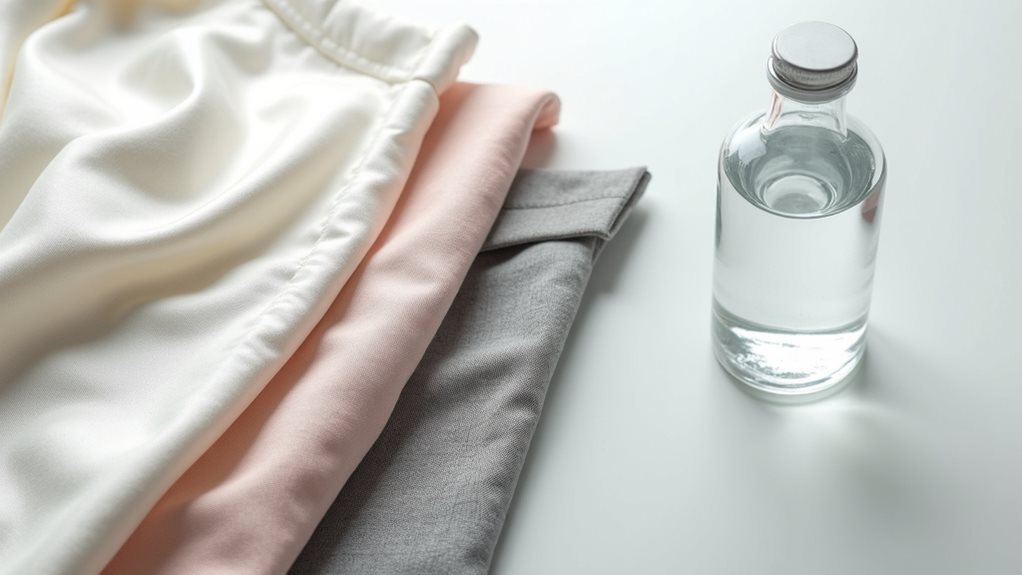
As someone who learned this lesson the hard way after accidentally ruining my favorite silk blouse with a home washing attempt, I can tell you that understanding which fabrics thrive under dry cleaning‘s gentle touch versus those that might suffer can save you both heartbreak and money.
Modern dry cleaning work excels with delicate fabrics like:
- Silk scarves that shimmer under office lights
- Cashmere sweaters soft as clouds against your skin
- Wool coats that withstand winter’s bite
- Structured blazers maintaining crisp professional lines
This cleaning utilizes alternative solvents for stubborn stains and fabric preservation.
However, always check your care label—sequins and plastic blends don’t play nice with the chemical used.
Always peek at those care labels first—some fabrics and embellishments simply weren’t made for dry cleaning’s chemical embrace.
While dry cleaning tackles oil-based messes beautifully, it struggles with water-based stains like coffee spills.
Professional dry cleaners possess the specialized equipment necessary to handle intricate construction details and maintain the longevity of your investment pieces.
Environmental Impact and Sustainable Alternatives

While browsing my local dry cleaner’s place storefront last month, I noticed a small green certification sticker that sparked my curiosity about what happens behind those swinging plastic curtains—and honestly, what I discovered about traditional dry cleaning’s environmental impact left me feeling a bit guilty about my weekly garment care routine.
The old-school cleaning process relies heavily on perchloroethylene, a chemical that’s about as eco-friendly as a gas-guzzling monster truck 🚛.
Thankfully, sustainable alternatives are emerging faster than wrinkles on linen, including liquid carbon dioxide systems and energy-efficient machines with impressive solvent recovery rates.
These biodegradable methods and eco-friendly cleaning innovations are transforming how we care for our favorite fabrics without harming Mother Earth.
For everyday garment maintenance, many people are turning to steam cleaning methods and professional wet cleaning techniques that use specialized detergents instead of harsh chemicals.

